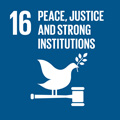- Docente: Anna Maria Lorusso
- Credits: 6
- SSD: M-FIL/05
- Language: Italian
- Teaching Mode: Traditional lectures
- Campus: Bologna
-
Corso:
First cycle degree programme (L) in
Communication Sciences (cod. 5975)
Also valid for First cycle degree programme (L) in Communication Sciences (cod. 8885)
-
from Feb 11, 2025 to Mar 20, 2025
Learning outcomes
The student, at the end of the course, will have a general knowledge of rhetorical-discursive strategies of the information world, in its different fields: tv, newpapers, web.. A special attention will be paid to strategies of manipulation, agenda setting, spectacularization that are at the base of newsmaking and to the dialogue between press, TV and web.
Course contents
The course aims to provide methodological tools adequate to a critical analysis, semiotically oriented, of the informative media discourses. In particular we will consider: the newspapers for the traditional press; TV news and infotainment programs for the television discourses; some cases of digital news (on social networks as well).
The course will proceed in different phases:
1. Methodological introduction and crucial issues in the contemporary informative scape
2. Focus on the problem of "post-truth"
3. Analysis of the press and of websites
4. Analysis of the tv news
5. Analysis of tv infotainment
As I've already told, the methodology of analysis that will be adopted will be semiotic, so the course is reccomended only to those who already have some bases in semiotics and to those Erasmus students who are able to UNDERSTAND Italian readings (not only bibliographical materials, but also cases analysis). I emphasize "understand" because the discussion could be done in English (or French or Spanish), but the reading material is in Italian.
From a thematic point of view, special attention will be paid to the problem of the relationship between representation-reality-truth.
We will go through the semiotic theme of veridiction, we will question the special nature and characteristics of a "mediatic case", we will deepen the concepts of manipulation and "truth effect". Crucial will be the use of semiotics of the passions (because of the emotionality of much of the contemporary informative discourses) and the category of model reader/viewer model .
In this frame, we will focus on the contemporary problem of the so called "post-truth".
Readings/Bibliography
•A.M..Lorusso-P.Violi, Semiotica del testo giornalistico, Roma-Bari, alterza, 2005
•P.Peverini, I media: strumenti di analisi semiotica, Roma, Carocci, 2012 (cap 3 e 4)
U.Eco, Sette anni di desiderio, Milano, Bompiani, 1983, parte IV "Il desiderio di trasparenza"
•A.M. Lorusso, Postverità, Roma-Bari, Laterza, 2018
There are no differences in bibligoraphy for students which don't follow classes.
However, for those who have never done a semiotic textual analysis, we recommend a basic preparation.
Teaching methods
The course will alternate to traditional lectures some more seminar lessons, dedicated to the analysis of case analysis.
Students will be asked to participate actively, collaborating in the class analyzes of the proposed texts.
Anyone who wishes can present their own analysis case.
Therefore it is strongly recommended to attend the course.
Assessment methods
The exam is written and consists of a semiotic analysis of a text chosen by the teacher (newspaper article, television segment, site ..) on which there will be three questions.
The exam will be taken on PC.
ERASMUS STUDENTS could write the exam in English, or French or Spanish (but the text to analyze will be in Italian, because it is the same for all the students).
Students with disabilities and Specific Learning Disorders (SLD)
Students with disabilities or Specific Learning Disorders are entitled to special adjustments according to their condition, subject to assessment by the University Service for Students with Disabilities and SLD. Please do not contact teachers or Department staff, but make an appointment with the Service. The Service will then determine what adjustments are specifically appropriate, and get in touch with the teacher. For more information, please visit the page:
https://site.unibo.it/studenti-con-disabilita-e-dsa/en/for-students
Teaching tools
The teacher will upload some in-depth materials (readings or case analyses)on Virtuale site.
This material will not be mandatory, but will only be supplementary and optional.
Office hours
See the website of Anna Maria Lorusso
SDGs



This teaching activity contributes to the achievement of the Sustainable Development Goals of the UN 2030 Agenda.
